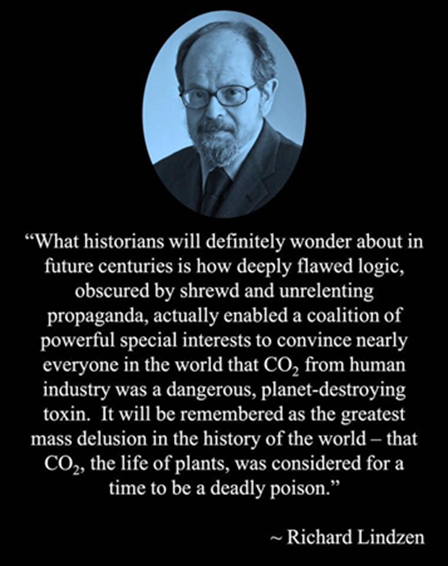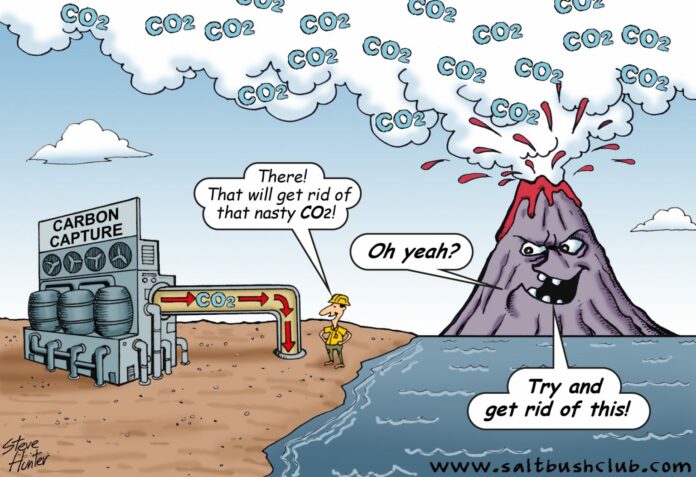 Carbon-capture-and-underground-storage “(CCUS)” tops the list of silly schemes “to reduce man-made global warming”. The idea is to capture exhaust gases from power stations or cement plants, separate the CO2 from the other gases, compress it, pump it to the chosen burial site and force it underground into permeable rock formations. Then hope it never escapes.
Carbon-capture-and-underground-storage “(CCUS)” tops the list of silly schemes “to reduce man-made global warming”. The idea is to capture exhaust gases from power stations or cement plants, separate the CO2 from the other gases, compress it, pump it to the chosen burial site and force it underground into permeable rock formations. Then hope it never escapes.
An Australian mining company who should know better is hoping to appease green critics by proposing to bury the gas of life, CO2, deep in the sedimentary rocks of Australia’s Great Artesian Basin.
They have chosen the Precipice Sandstone for their carbon cemetery. However the chances of keeping CO2 gas confined in this porous sandstone are remote. This formation has a very large area of outcrop to the surface and gas will escape somewhere, so why bother forcing it into a jail with no roof?
Glencore shareholders should rise in anger at this wasteful and futile pagan sacrifice to the global warming gods. It will join fiascos like Snowy 2, pink bats and SunCable (a dream to take solar energy generated in NT via overhead and undersea cable for over 5000 km across ocean deeps and volcanic belts to Singapore
Engineers with buckets of easy money may base a whole career on Carbon Capture and Underground Storage. But only stupid green zealots would support the sacrifice of billions of investment dollars and scads of energy to bury this harmless, invisible, life-supporting gas in the hope of appeasing the high priests of global warming.

The quantities of gases that CCUS would need to handle are enormous, and the capital and operating costs will be horrendous. It is a dreadful waste of energy and resources, consuming about twenty percent of power delivered from an otherwise efficient coal-fired power station.
For every tonne of coal burnt in a power station, about 11 tonnes of gases are exhausted – 7.5 tonnes of nitrogen from the air used to burn the coal, plus 2.5 tonnes of CO2 and one tonne of water vapour from the coal combustion process.
Normally these beneficial atmospheric gases are released to the atmosphere after filters take out any nasties like soot and noxious fumes.
However, CCUS also requires energy to produce and fabricate steel and erect gas storages, pumps and pipelines and to drill disposal wells. This will chew up more coal resources and produce yet more carbon dioxide, for zero benefit.
But the real problems are at the burial site – how to create a secure space to hold the CO2 gas.
There is no vacuum occurring naturally anywhere on earth – every bit of space on Earth is occupied by something – solids, liquids or gases. Underground disposal of CO2 requires it to be pumped AGAINST the pressure of whatever fills the pore space of the rock formation now – either natural gases or liquids. These pressures can be substantial, especially after more gas is pumped in.
The natural gases in sedimentary rock formations are commonly air, CO2, CH4 (methane) or rarely, H2S (rotten egg gas). The liquids are commonly salty water, sometimes fresh water or very rarely, liquid hydrocarbons.
Pumping out air is costly; pumping out natural CO2 to make room for man-made CO2 is pointless; and releasing rotten egg gas or salty water on the surface would create a real problem, unlike the imaginary threat from CO2.
In some cases CCUS may require the removal of fresh water to make space for CO2.
Producing fresh water on the surface would be seen as a boon by most locals. Pumping out salt water to make space to bury CO2 would create more problems than it could solve.
Naturally, some carbon dioxide buried under pressure will dissolve in groundwater and aerate it, so that the next water driller in the area could get a real bonus – bubbling Perrier Water on tap, worth more than oil.
Then there is the dangerous risk of a surface outburst or leakage from a pressurised underground reservoir of CO2. The atmosphere contains 0.04% CO2 which is beneficial for all life. But the gas in a CCUS reservoir would contain +90% of this heavier-than-air gas – a lethal, suffocating concentration for nearby animal life if it escaped in a gas outburst.
Pumping gases underground is only sensible if it brings real benefits such as using waste gases to increase oil recovery from declining oil fields – frack the strata, pump in CO2 and force out oil/gas. To find a place where you could drive out natural hydro-carbons in order to make space to bury CO2 would be like winning the Lottery – a profitable but unlikely event.
Normally however, CCUS will be futile as the oceans will largely undo whatever man tries to do with CO2 in the atmosphere. Oceans contain vastly more CO2 than the thin puny atmosphere, and oceans maintain equilibrium between CO2 in the atmosphere and CO2 dissolved in the oceans. If man releases CO2 into the atmosphere, the oceans will quickly absorb much of it. And if by some fluke man reduced the CO2 in the atmosphere, CO2 would bubble out of the oceans to replace much of it. Or just one decent volcanic explosion could negate the whole CCUS exercise.
Increased CO2 in the atmosphere encourages all plants to grow better and use more CO2. Unfortunately natural processes are continually sequestering huge tonnages of CO2 into extensive deposits of shale, coal, limestone, dolomite and magnesite – this process has driven atmospheric CO2 to dangerously low concentrations. Burning hydrocarbons and making cement returns a tiny bit of this plant food from the lithosphere to the biosphere.
Regulating atmospheric carbon dioxide is best left to the oceans and plants – they have been doing it successfully for millennia.
The only certain outcome from CCUS is more expensive electricity and a waste of energy resources to do all the separation, compressing and pumping. Unscrupulous Coal industry leaders love the idea of selling more coal to produce the same amount of electricity and electricity generators would welcome an increased demand for power. And green zealots in USA plan to force all coal and gas plants to bury all CO2 plant food that they generate. Consumers and taxpayers are the suckers.
Naturally the Greens love the idea of making coal and gas-fired electricity more expensive. They conveniently ignore the fact that CCUS is anti-life – it steals plant food from the biosphere.
Global Warming has never been a threat to life on Earth – Ice is the killer.
Glencore directors supporting this CCUS stupidity should be condemned for destructive ignorance.
Further Reading:
Atmospheric levels of CO2 fall close to the RED LINE OF DEATH:
https://carbon-sense.com/2022/04/18/the-red-line-of-death/
Nature controls the level of CO2 in the atmosphere:
Ocean Temperature Controls CO2:
https://carbon-sense.com/2010/12/29/forbes-co2-and-oceans
http://carbon-sense.com/wp-content/uploads/2010/12/endersbee-co2-and-oceans.pdf
The Insane Plan of the UK Government to Decarbonise the Economy:
https://principia-scientific.org/uk-governments-insane-plan-to-decarbonize-the-economy
Outburst dangers from entrapped carbon dioxide:
The Cost of the EPA CO2 capture Rule:
https://co2coalition.org/2024/05/07/the-cost-of-epas-senseless-co2-capture/
Originally published at Richardson Post.










